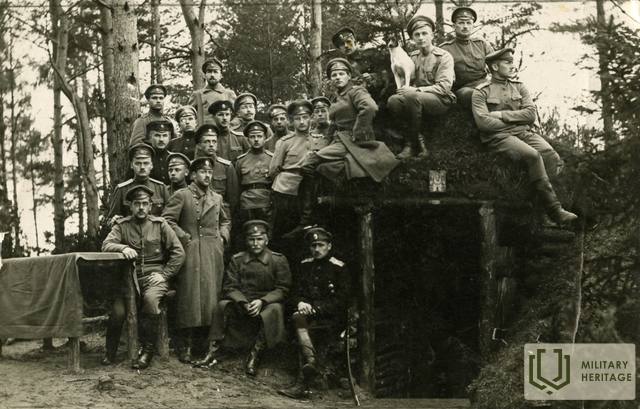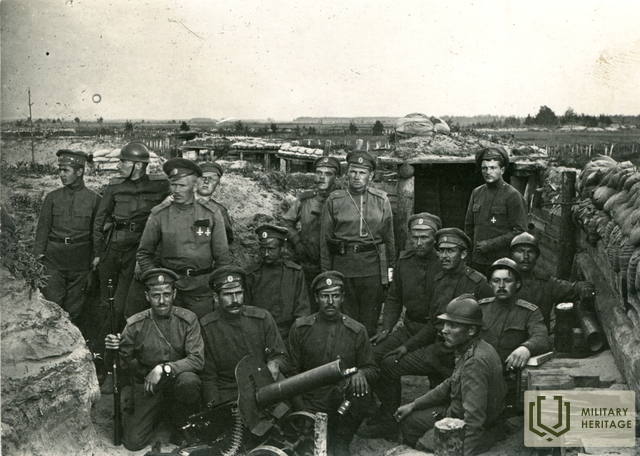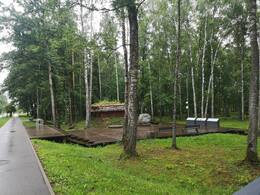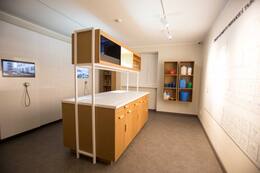Apie Latvijos šaulius Olainės apylinkėse

Memuaruose atsispindi kasdienis Latvijos šaulių gyvenimas Olainės apylinkėse. Aprašomos ne tik gyvenimo sąlygos, bet ir jų įprasta užduotis – priešo pozicijų žvalgyba.
(..) Nakvojome netoli mūšio lauko, artilerijos bunkeriuose. Ryte turėjome vykti į „Lapsą“, netoli Olainės stoties, kur kelias dienas ir naktis praleidome po atviru dangumi, miške. Sužinoję, kad dar kelias dienas teks pasilikti vietoje, energingai ėmėmės statyti molinius namelius. Durys į apkasus, dėl lentų trūkumo, buvo pagamintos iš eglių šakų. Vielos vyriams ir plytų krosnims pilnai buvo galima gauti sunaikintoje Olainės stotyje, kur, kaip pasakojo mūsų kaimynai rusai, negalėjome eiti, nes vokiečiai galėjo matyti ir šaudyti. Maždaug po savaitės išvykome iš „Lapsos“ ir nuvykome į bataliono štabą, kuris buvo įsikūręs netoli Baložių stoties. (..)
(..) Vos pasirodžius vokiečių raketai, nors jų apkasai yra kitoje pelkės pusėje, mes atsigulame. Rytui išaušus, pasiskirstome į ploną grandinę. Mūsų mokomoji komanda yra dešiniajame grandinės sparne. Kol pasiekėme vokiečių apkasus, turime ilgai eiti per mažus, sniegu padengtus krūmynus, su kiekvienu prisilietimu sniegas krenta už apykaklių, kojos grimzta į pelkę, o daiktų maišas tempia pečius. Eidami per krūmus, turime būti atsargūs, kad nenutoltume vienas nuo kito. Visą laiką girdime kulkosvaidžių šūvius kairiajame grandinės sparne, kur buvo dislokuota mūsų kuopa. Pradeda veikti ir mūsų artilerija. Kulkos taip pat pradeda švilpti link mūsų. Vienos švilpia pro šalį, kitos sprogsta priešais mus, pataikydamos į medžio šaką. Mes nešaudome, nes nematome priešo, o tiesiog judame į priekį. Nė viena priešo kulka taip pat nesislepia. Galime pradėti ir čia, nes „Fricai“ yra arti. Šaudymas ėmė stiprėti. Netoliese girdžiu ilgą, išsitęsusį dejonę, kuri kulkų šnypštimo fone palieka slegiantį įspūdį. Vienas mūsų bendražygis krito. Greitai jį nurengiame; krūtinėje matosi maža skylutė, pro kurią teka nauja gyvybė. Antrasis taip pat krito. Prisimenu vieną Tukumo apskrities ūkininką Mūrį, kuris jau tikėjo Latvija ir jautė didžiausią neapykantą vokiečiams. Jis dingo po mūšio. Tik kitą pavasarį rusų kareiviai rado jo kūną. Nevalingai suvokiu, kaip žuvo visi tie, kurie labiausiai mylėjo Latvijos žmones, pradedant Briežiu ir baigiant nežinomu, nepastebėtu šauliu. Taip, jie turėjo šviesias sielas. Pereiname taką, iškaltą per mišką. Atsigulame. Kai kurie drąsesni stovi. Vokiečiai nutilo. Paprašėme savo vado leidimo pulti vokiečių apkasus, bet kadangi mūsų kuopa negalėjo prasiveržti į vokiečių apkasus, mums nebuvo leista to padaryti. Neturėjome ir pastiprinimo. Buvome tik plona linija. Gulėjome ant virvės ir stebėjome. Čia vienas iš mūsų bendražygių, drąsus kuršis, žuvęs kovo mūšyje, paleido šūvį. Matėme vokišką šalmą, skrendantį virš mažų beržų. Kitu šūviu kitas bendražygis nužudė dar vieną vokietį. Abu vokiečiai nešėsi dėžę šovinių. Čia pamačiau kažką judant priešais esančiuose krūmuose, pasakiau šalia esančiam bendražygiui, kaip šaudyti. Abu šovėme vienu metu. Tuoj pat krūmai prasiskyrė ir pasirodė senas vokietis su kraujuojančia ranka, kuris su savo šalmu ir dygliuota barzda sudarė Mefistofelio įspūdį. Jis šaukė nešauti, nes namuose buvo penki vaikai. Mes jį pagavome, bet buvo nenatūralu jį liesti. Jį išsivežė rusų kareiviai. Su mano palyginimu, galbūt aš jam darau neteisybę, galbūt jis buvo sąžiningas šeimos žmogus, atitrūkęs nuo kasdienio darbo, bet tą akimirką jis paliko blogą įspūdį. Buvo ir vėliau laikas, kai labai pasipiktinau karu, matydamas sunkiai sužeisto priešo kančias. Bet visos tokios akimirkos galėjo palikti tik trumpalaikį įspūdį, nes buvo karas...
Laikraštis “Jēkabpils Vēstnesis”. 1925 metų sausis.
Susijusi laiko juosta
Susijusios vietos
Pirmojo pasaulinio karo istorinių žvalgybų maršrutas ir apkasas
Įsikūręs Olainėje, netoli Olainės istorijos ir meno muziejaus.
Istorinis maršrutas buvo sukurtas 2018 m. Pirmojo pasaulinio karo metu buvusių Rusijos armijos įtvirtinimų, kurie buvo vietovės gynybos sistemos dalis, vietoje. Vokietijos ir Rusijos armijų mūšiai Olainės apylinkėse patraukia dėmesį dėl kelių priežasčių. Pelkėta vietovė neleido kariaujančioms šalims greitai pasiekti sėkmės ir reikalavo iš kareivių įvairiapusiškų įgūdžių, veikiant nepalankiomis sąlygomis. Karo metu svarbų vaidmenį atliko tiksli reljefo analizė, žvalgyba, įtvirtinimai ar inžineriniai statiniai.
Šiandien edukacinis maršrutas yra laisvai prieinamas ir suteikia apytikslį vaizdą apie karių gyvenimo sąlygas. Restauruoti pastatai yra uždaryti, tačiau juos galima apžiūrėti iš anksto susisiekus su Olainės istorijos ir meno muziejaus specialistais.
Olaine istorijos ir meno muziejus
Olainės istorijos ir meno muziejaus ekspozicija pasakoja apie sovietinės okupacijos laikotarpį Olainėje. Muziejaus teritorijoje sukurtas Pirmojo pasaulinio karo žvalgybinis maršrutas su restauruotais įtvirtinimų elementais. Vietoje, kur anksčiau buvo Pirmojo pasaulinio karo Rusijos armijos gynybos linija, pastatytas rusų kareivio tipo apkasas, o lankytojai gali apžiūrėti šaudymo bokšto fragmentą. Jaunolainėje, sankryžoje su Plakanciemu, galima pamatyti Pirmojo pasaulinio karo gelžbetoninį įtvirtinimą. Pirmojo pasaulinio karo metu šioje vietovėje vyko aktyvūs mūšiai tarp Rusijos ir Vokietijos armijų. Latvijos šaulių daliniai dalyvavo žvalgyboje ir įvairiose kitose operacijose. Pelkėtos žemės apsunkino gynybą, tačiau tai buvo labai svarbi teritorija Latvijos karinėje istorijoje. Olainė susiformavo dėl patogios vietos tarp Jelgavos ir Rygos, kur šiuo metu yra Jaunolainė. Netoliese buvo Olainės dvaras. Dabartinė Olainė buvo pastatyta sovietinės okupacijos metu, kai čia pradėjo veikti pramonės įmonės.








